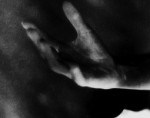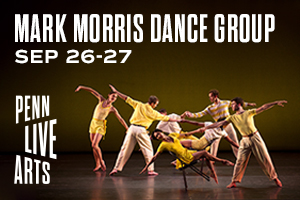
Le Corps (The Body)
by E. Wallis Cain Carbonell
Montpellier Danse’s 45th International Summer Festival was the final curatorial offering from Jean-Paul Montanari, who served as director since 1983 and passed away this year. Also, the previously separate National Choreographic Centre of Montpellier and Montpellier Danse have joined forces as Agora, looking ahead to future festival curation with a focus on contemporary works, creation processes, and innovation.
Akram Khan & Manal AlDowoyan’s Thikra: Night of Remembering marked the return of a festival favorite, as well as a deep dive into the ancient past. Originally performed at the ruins of AlUla—archaeological remains recently discovered in Saudi Arabia—Khan brought an imagined sacrificial ritual to the stage with set and costumes by AlDowoyan. While I longed to witness the original location, the all-female cast’s use of hair biting, masks, and Bharatanatyam dance grounded a space where blood was demanded, repeatedly.
Repetition was a recurring theme throughout the festival, also playing a key role in Amit Noy’s athletic and sexually sadistic Good Luck, the solo femme containment of Armin Hokmi’s Of the Heart-an Etude, and in the extended terre-à-terre allusions to migratory patterning of Lenio Kaklea’s The Birds.
Even more emphatically so, Cherish Menzo’s FRANK employed repetition to support her arsenal of tools, immersing her audience in a“metamorphosis and decomposition between the Self and the Other” (Agnès Izrine). Menzo, along with three other Black performers, centered the African diaspora utilizing krump, contemporary, and hip-hop forms. They paced around the dance floor, transforming plastic curtains into a chandelier and singing a tragic and depleted version of Bam Bam. Mouths reddened, the artists spoke the words “collapse” and “le corps” as they evidenced how humanity is complicit in monster creation. A masterful reflection of Black reality, FRANK was part three of Menzo’s trilogy (beginning with JEZEBEL and DARKMATTER). DARKMATTER will travel to the USA in the coming year.
Friends of Forsythe brought a sparser exploration of repetition to the festival, with a collaboration between William Forsythe and Rauf “RubberLegz” Yasit. Emerging from a slow, tangled knot, the dancers find a universal language between different vocabularies and approaches to negative space in a rhythmic meditation, infusing the competitive play of b-boy culture into otherwise classically structured call and response duet forms.
Far from sparse, Nederlands Dans Theatre & Complicity brought Crystal Pite & Simon McBurney’s highly touted Figures in Extinction to the 2000-seat Corum Theatre. The cast of 23 dancers portrayed gorgeous, albeit extinct, animals in the first part of the triptych. “The more we know, the further away they are,” was messaging which rang true in the narration (a favorite in Pite’s repertoire). “We are the core of the dead,” echoed in my ears long after the show ended.
Echoing in my vision was the heap of stage props atop a woman whose body yearned to float away in Camille Boitel & Sève Bernard’s « ». Right from the beginning, people and things were endlessly falling, and the color red directed our focus from one vignette to the next; the whole cast adjusted reality to support one man’s delusions in one scene and another bringing forth thirst, spillage, and eventually everything rocking. The audience laughed heartily throughout. This was a world turned upside down for one person, hinting that the results could be tragic.
Israel Galván & Michael Leonhart headlined A New Sketches of Spain on the same outdoor stage at L’Agora. Accompanying Leonhart (the trumpeter/conductor) and Galván (the flamenco dancer), there were five additional musicians, helping to bring the spirit of American jazz to the table through the songs of Miles Davis alongside incredible moments of improvisation, listening, and live choice-making.
The Hangar Theatre has long been a site for risk-taking. Here, Eric Minh Cuong Castaing’s Forme(s) de vie featured disabled and non-disabled dancers in a 45-minute program of poetic realism. David Wampach’s Du Folie made its premiere in the same space, complete with clowning gestures, red benches, a faux epileptic seizure, yelling, and balloon heads.
Montpellier-based artists Salia Sanou, Mathilde Monnier, and Nadia Beugré rounded out the program, providing hope for the future. Burkinabe artist Sanou holds Bach and African music to an equal level beyond reproach in his hybrid choreography Des Fugues…En Suites. Monnier’s Territoires amplified her prolific and uniting influence in the heart and home of the ICI-CCN, reminding viewers that things are more precious when they can be missed.
The women of Beugré’s Epic! (for Yikakou) offered a jaw-droppingly beautiful trio of Black sensory experience, complete with sand, shea butter, sticks, humor, sex, and femininity. Maxing out each prop, they created a web of mutual support that pointed to the future.
This pivotal year for Montpellier’s Festival begged me to wonder about un-knowing what is next. I hope to see headliners willing to take chances. I also hope to see artists who are new to the festival with audiences willing to take risks with them.
Montpellier Dance, 45th International Festival, Montpellier, France, June 21-July 5.
Homepage Image Description: With eyes closed, Nadia Beugré holds a stick in her mouth and tilts her head to the left. More wooden sticks frame her face. She is sweaty, her right arm strong and flexed.
Article Image Description: Wearing sharp pantsuits, a group of approximately one dozen dancers from Netherlands Dans Theatre & Complicity lean away from one man in the middle, hair pomaded, gesturing directly to the audience.
By E. Wallis Cain Carbonell
July 18, 2025










